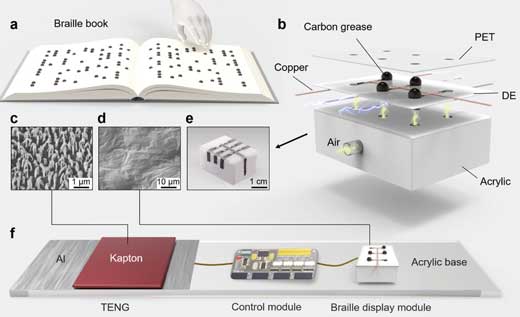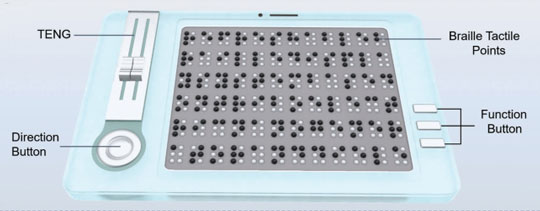| Nov 05, 2020 | |
Concept design for a user-powered, refreshable Braille e-book reader for the blind |
|
| (Nanowerk Spotlight) In order to make dynamic written content, for instance a news reader, available for blind or vision-impaired people, scientists have come up with various designs of sheet-type, refreshable Braille displays. | |
| Typically, these Braille displays are tactile, electromechanical devices for displaying Braille characters, consisting of a row of refreshable cells. A refreshable cell has 6 or 8 pins, which are controlled electronically to move up and down to display characters as they appear on a computer display. A number of cells are placed next to each other to form a soft or refreshable Braille line. As the little pins of each cell pop up and down they form a line of Braille text that can be read by touch. | |
| Researchers have developed variety of actuation techniques for the pins, for instance by integrating organic thin-film transistors and soft polymer actuators, or by using carbon nanotube-based actuators. | |
| Expanding the use of nanotechnologies in designing next-generation Braille readers, researchers now have successfully demonstrated a refreshable Braille display system by using a safe high-voltage power source – a triboelectric nanogenerator (TENG). | |
| The triboelectric effect is the build-up of an electric charge between two materials through contact and separation – you experience this effect when taking off a shirt or sweater, especially in dry air, results in crackling. Its theoretical origin can be traced back to Maxwell's equations, which gives TENGs their unique output characteristics of high voltage and low current. | |
| Dozens of nanotechnology research groups around the world are working on the development of TENGs for harvesting energy from mechanical vibrations. The huge interest in TENGs stems from their ability to convert ambient mechanical energy – however small – into electricity for powering wearable electronics, energy generation using sound, sensor networks, removing air pollution with nanogenerator-enhanced air filters, implantable medical devices, and other small systems (read more: "On route to self-powered smart suits"). | |
| Reporting their findings in Advanced Functional Materials ("Refreshable Braille Display System Based on Triboelectric Nanogenerator and Dielectric Elastomer"), a team of researchers from the Beijing Institute of Nanoenergy and Nanosystems demonstrates a refreshable Braille display system (RBDS) based on a TENG and dielectric elastomer membranes. | |
 |
|
| Design of the refreshable Braille display system (RBDS). a) Schematic diagram of a conventional Braille book. b) Exploded view of the Braille display module. c) SEM image of nanostructure on the surface of Kapton film treated by ICP reactive-ion etching. d) SEM image of the carbon grease on the DED. e) Photo of the Braille display module. f) Schematic diagram of the RBDS with control module. (Reprinted with permission by Wiley-VCH Verlag) (click on image to enlarge) | |
| "Dielectric elastomer is lightweight, flexible and capable of rapid deformation under the actuation of high voltage, so we hypothesized it might be suitable for making Braille display devices," Prof. Zhou Li, one of the authors of the paper, explains to Nanowerk. "However, the required high-voltage power supply could be dangerous to the human body. In contrast, a TENG generates enough output voltage to actuate the dielectric elastomer but the low current it generates is safe for the user." | |
| Dielectric elastomer is a lightweight, electroactive polymer that can deform greatly and rapidly under the action of an electric field, and can restore its original size immediately after the electric field disappears. | |
| The researchers used dielectric elastomer membranes to fabricate the Braille dots for their display. They are raised and lowered through the combined effect of high voltage and air pressure inside the display module. | |
 |
|
| Braille letters of T, E, N and G displayed by a single Braille device operated by an electronic switch controller. (Reprinted with permission by Wiley-VCH Verlag) | |
| The core component of the team's system is a Braille display module consisting of dielectric elastomer dots, flexible electrodes and an air chamber. The TENG acts as a high-voltage source, made by an acrylic sheet, an aluminum foil and a Kapton film. | |
| "We used carbon grease electrodes, which are functionalized by silicon nanoparticles, to make the electrodes stretchable," explains Prof. Xiangyu Chen, a co-author of the paper. "Initially, one of our concerns was the actual duration of how long a Braille dot is raised. To solve this, we used ICP etching technology to nanostructure the friction layer of the TENG in order to increase its surface area, enabling it to accumulate more charges, and thereby increasing the duration of contact protrusions." | |
| Finally, by integrating an electronic switch into their display system, the team turned a single six-dot Braille module from a static device into a dynamic device where the individual pins can be raised and lowered. This offers exciting future design possibilities – ultimately leading to the realization of Braille e-books. | |
| Since this work is the first prototype of a TENG-powered Braille display, the sliding type TENG chosen by the researchers is meant for demonstrating the working concept of the system. It's probably not an ideal solution for a commercial device desind. | |
 |
|
| Concept design of a future refreshable, simple, cost-effective, and safe Braille e-book for the blind. (Reprinted with permission by Wiley-VCH Verlag) | |
| "In our future work, there are many other types of TENGs with a more compact structure or simpler operation method that we can select, such as the charge pumping type TENG, rotating type TENG, and so on," Li and Chen conclude. "Furthermore, we are working towards realizing a large-scale Braille devices array and reduce the size of the whole system, such as modifying the dielectric elastomer membrane to reduce the required actuated voltage, designing the TENG as a multilayer array structure, and enhanceing the TENG's driving force. With advances in efficient energy storage, increased miniaturization, and improved longevity we see a bright future for TENGs in many areas of modern life." | |
 By
Michael
Berger
– Michael is author of three books by the Royal Society of Chemistry:
Nano-Society: Pushing the Boundaries of Technology,
Nanotechnology: The Future is Tiny, and
Nanoengineering: The Skills and Tools Making Technology Invisible
Copyright ©
Nanowerk LLC
By
Michael
Berger
– Michael is author of three books by the Royal Society of Chemistry:
Nano-Society: Pushing the Boundaries of Technology,
Nanotechnology: The Future is Tiny, and
Nanoengineering: The Skills and Tools Making Technology Invisible
Copyright ©
Nanowerk LLC
|
|
|
Become a Spotlight guest author! Join our large and growing group of guest contributors. Have you just published a scientific paper or have other exciting developments to share with the nanotechnology community? Here is how to publish on nanowerk.com. |
|
